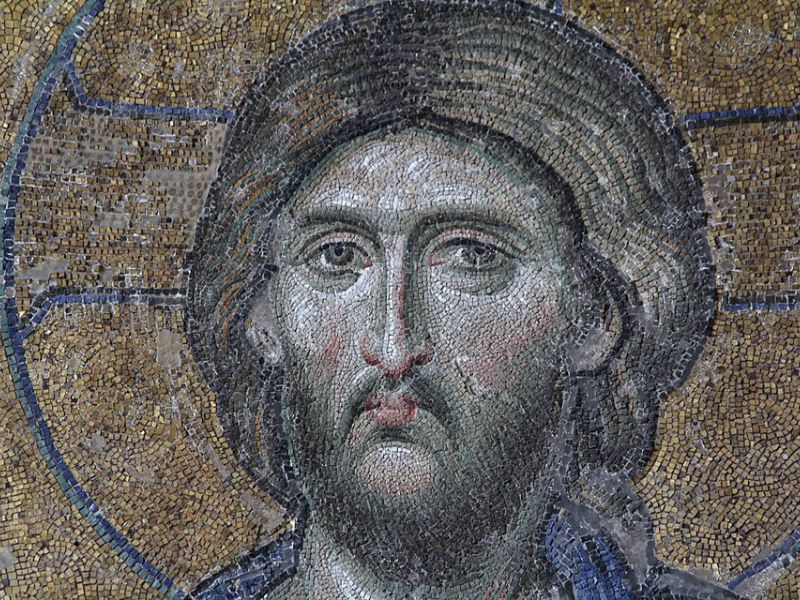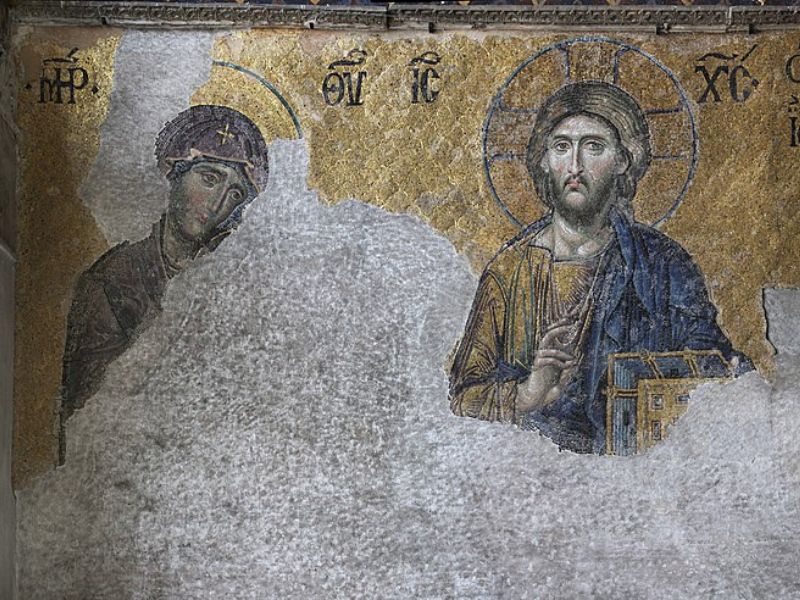Table of Contents
Introduction
Among the many treasures hidden within the walls of Hagia Sophia, the Deësis Mosaic stands as one of the most mesmerizing and enigmatic.
This stunning 13th-century Byzantine masterpiece, depicting Christ Pantocrator with the Virgin Mary and John the Baptist, is a profound representation of faith, suffering, and the Byzantine Empire’s devotion to divine mercy.
Unlike earlier mosaics in Hagia Sophia, the Deësis Mosaic was created during a period of crisis and uncertainty, when the Byzantine Empire was struggling to reclaim its former glory after the devastating Latin occupation of Constantinople.
The mosaic’s artistry reflects a shift in Byzantine religious expression, moving toward a more humanized and emotional portrayal of Christ and his intercessors. But despite its beauty and significance, the Deësis Mosaic remained hidden for centuries.
After the Ottoman conquest in 1453, it was plastered over and left forgotten, only to be rediscovered in the 20th century. What makes this mosaic so unique? Why was it created? And what does it tell us about the Byzantine devotion to Christ and the plea for salvation?
The Historical Context: The Empire in Crisis

The Deësis Mosaic was commissioned in the mid-13th century, a time of political upheaval and spiritual desperation for the Byzantine Empire.
In 1204, Constantinople was brutally sacked by Western Crusaders during the Fourth Crusade, and for more than 50 years, the city was under Latin rule. Byzantine emperors were exiled, churches were looted, and the once-glorious capital of Eastern Christianity fell into decline.
When the Byzantines finally reclaimed Constantinople in 1261, the empire was a shadow of its former self—weakened, impoverished, and struggling to rebuild. The Deësis Mosaic was likely created around this period, marking a return to Orthodox faith and a plea for divine mercy.
Unlike earlier imperial mosaics, which celebrated Byzantine power, this artwork conveys humility, repentance, and a desperate appeal for salvation. It reflects the empire’s spiritual longing for Christ’s mercy, as it faced an uncertain future.
The Artistic and Spiritual Significance of the Mosaic
Christ Pantocrator: The Supreme Judge
At the center of the Deësis Mosaic is Christ Pantocrator, depicted with deeply expressive eyes, soft facial features, and a solemn expression. This is not the rigid, all-powerful ruler of earlier Byzantine mosaics; instead, Christ appears gentle yet authoritative, embodying both judgment and mercy.
His right hand is raised in a gesture of blessing, while his left hand holds a Gospel book, symbolizing divine wisdom and salvation. The mosaic’s craftsmanship is remarkable, with delicate shading and gradations of color creating a lifelike, almost human quality—a testament to the skill of Byzantine artists.
The Virgin Mary and John the Baptist: Pleading for Humanity
To the left of Christ stands the Virgin Mary, and to his right, John the Baptist—both depicted in humble, sorrowful postures. Their hands are raised in a gesture of intercession, as if they are pleading with Christ to show mercy on humanity.
This composition follows the Deësis tradition (Greek for “supplication” or “prayer”), a Byzantine artistic motif where Mary and John act as mediators between Christ and mankind. Their solemn expressions reflect the Byzantine people’s desperate plea for divine intervention during their empire’s darkest days.
Unlike earlier mosaics that emphasized imperial grandeur, the Deësis Mosaic is deeply personal and emotional. The figures display individuality and sorrow, reflecting a more humanized and compassionate vision of faith.
The Concealment and Rediscovery of the Mosaic

The Ottoman Conversion of Hagia Sophia
When the Ottomans captured Constantinople in 1453, Hagia Sophia was transformed into an imperial mosque. In accordance with Islamic tradition, which prohibits the depiction of human figures in places of worship, the Christian mosaics were plastered over.
Unlike other Byzantine artworks that were destroyed, the Deësis Mosaic was simply covered, possibly because the Ottomans recognized its artistic value. For nearly five centuries, it remained hidden beneath layers of whitewash, forgotten by the world.
The 20th-Century Rediscovery
In 1935, following the secular reforms of Mustafa Kemal Atatürk, Hagia Sophia was converted into a museum, and a team of historians and conservators, led by Thomas Whittemore and the Byzantine Institute of America, began restoration work.
As they carefully removed layers of plaster, they uncovered the Deësis Mosaic, revealing its stunning detail and golden brilliance for the first time in centuries. However, parts of the mosaic had suffered damage, with entire sections missing, particularly in the lower parts of the figures.
Despite its incomplete state, the rediscovery of the Deësis Mosaic was a historic moment, shedding new light on Byzantine artistry and religious devotion.
The Emotional and Religious Power of the Mosaic

A Testament to Byzantine Devotion
The Deësis Mosaic stands as one of the most intimate and emotional religious depictions in Byzantine art. It reflects a period when faith was no longer tied to imperial power but to personal spirituality and divine mercy.
Unlike earlier mosaics that glorified emperors, the Deësis Mosaic speaks directly to the individual. Looking into the eyes of Christ Pantocrator, one can feel the weight of divine judgment and compassion. The presence of Mary and John reinforces the hope that even in times of despair, salvation is possible through faith and intercession.
A Symbol of Loss and Survival
The mosaic’s damaged state serves as a reminder of Constantinople’s turbulent history—wars, conquests, and cultural shifts that shaped its fate. Yet, despite these challenges, the mosaic survived, much like the Byzantine spirit itself.
For modern visitors, standing before the Deësis Mosaic is a deeply moving experience. It is a silent witness to centuries of prayer, struggle, and resilience, bridging the past with the present.
The Future of the Deësis Mosaic in Hagia Sophia
Following Hagia Sophia’s reconversion into a mosque in 2020, concerns arose over the visibility and preservation of its Christian mosaics. Currently, the Deësis Mosaic, along with other Byzantine artworks, is covered during prayer times, sparking debates over historical preservation and cultural heritage.
While Turkish authorities have assured that the mosaics will not be harmed, access to them remains limited, raising questions about their future. Many historians and cultural organizations advocate for continued restoration efforts, ensuring that these masterpieces remain visible for generations to come.
Conclusion
The Deësis Mosaic of Hagia Sophia is more than just an artistic achievement; it is a reflection of Byzantine devotion, suffering, and hope. Created during an era of imperial decline, it conveys a powerful message of faith in times of crisis.
Though hidden for centuries, its rediscovery revealed a lost masterpiece, bridging the Byzantine and modern worlds. Whether viewed as a sacred relic or a universal treasure, the Deësis Mosaic continues to captivate and inspire, reminding us that art and faith endure—even in the face of time and history.






